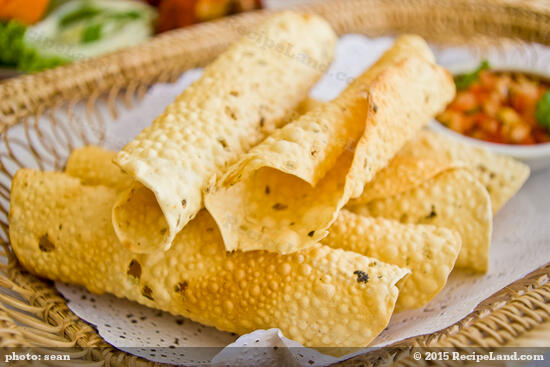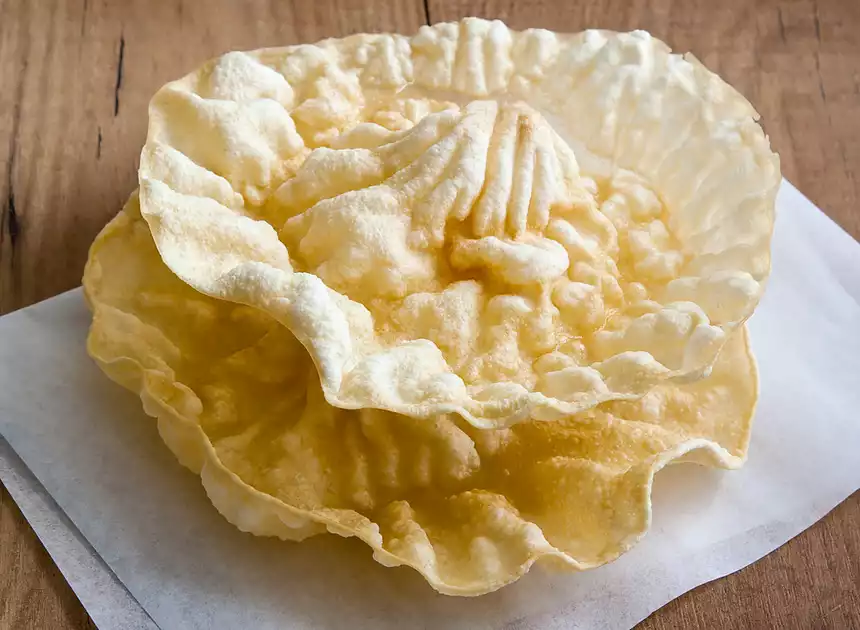Thin Indian crispy cracker or flatbread. Typically served as an appetizer to an Indian meal. It can also be eaten as a snack and can be topped with chopped onions, peppers, chutney’s or other condiments.
YIELD
8 servingsPREP
20 minCOOK
90 minREADY
120 minIngredients
Directions
In a large bowl mix the flour, black pepper, cumin, and salt. Add the water and knead the dough by hand until it is smooth.
Depending on the flour you may need to add more or less water to reach the desired consistency. It should be wet enough to hold together but not too sticky.
Divide the dough into 12 to 15 balls and roll out one ball at a time to a very thin round layer about ⅛ inch thick on a lightly oiled surface.
Place on lightly oiled cookie sheets. Place the papadums in the oven preheated to about 200℉ (100℃) F. Store in an airtight container until ready to serve.
Fry in a non-stick skillet in a small amount of oil (or you could dry fry them) until they are crispy but do not let them brown.

Serve warm. They can also be made ahead and then be crisped up in a warm oven before serving.



It was hard to get the dough thin enough, despite the fact that we made them no larger than 3 inches wide. I think adding some wheat flour would have probably helped. They tasted very lentily and strong. I really was not impressed.
See the video link just added. Will need to update the directions for this recipe. To get them to roll thinly the dough needs to be pounded and then stretched to obtain the right texture.
I have chickpea flour, instead of lentil flour, would this change the recipe? I think I prefer the taste of the chickpea flour.
Poop, this recipe tastes like the lent underneeth my feet when i am in South Korea -69/10 not LEET 0% Lit
Thank you for this! Just what I was looking for.
I tasted some papadum left over from an Indian dhal (also spelled daal) workshop the evening before. The instructor brought the papadum from a market in San Francisco specializing in foods from India located near UCSF where she teaches. She indicated most Indian food markets carry papadum and that these in particular were made of a combination of garbanzo (chickpea) flour and lentil flour with added seeds and spices. I would offer the observation that lentils du puy are possibly not the best choice for grinding into lentil flour because they are a European type with characteristics unlike the varieties grown in India. These papadum were so light, crispy and flavorful that my coworkers and I discussed their attributes for a good while. They were piquant and robust with spicy flavor. I can hardly wait to get my hands on a recipe that will reproduce the papadum I tasted.
Kikärtsmjöl ger betydligt mörare bröd. Jag föredrar att göra dem riktigt tunna, ca 1-2 mm tjocka. Kavla ut degen mellan 2 lager plastfolie så går det lättare.
I see the recipe calls for 4 cups of lentils for making the flour. I am wondering how much actual flour this creates for the recipe. I would guess about a cup of ground flour, just based on the amount of liquid that is added. Could you clarify this for me? I'd really like to make this, but will probably buy lentil flour. Thanks.
This recipe is supposed to be written on my Chef Receive booklet, but thanks to my sister, it was lost! I wasted 12 years best collections dishes on them. No way to get them back, so I could never copy a recipe for a mouthful of papadam.
The dhal type will alter the final product. Urad dhal flour (see "Vigna mungo" on Wikipedia) is the best. Asian food shops have it, or buy online. Has many names, commonly sold as urad dhal, the bean as grown looks black, but the polished (de-hulled) bean is white. The bean (dhal) has many other uses, as in making "dhosas". Grind dhal to flour in a sturdy mill, or buy as "papad flour".
I learned about papadam today, which I shall spread my classic hummus over, while enjoying the Dallas Cowboys game on tomorrow. Chickpea flour is my choice.
Rubbish!
very nice explanation mam really love it.we also make(manufacture) appalam and papad at factory kindly visit us on
https://www.mahaganapathifoods.com
Thanks my frient